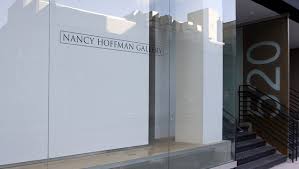The original interview was made in conjunction with the exhibition "Hyperrealismes USA" co-curated by J-C Lebensztejn.
The exhibition was shown at the Musee d'art moderne in Strasbourg, France, Summer 2003. A fuller version of the interview will appear in the Museum's exhibition catalogue.
The version presented here is an abridged, excerpted and revised adaptation by J.R. for the purposes of presenting it in simpler form on his website josephraffael.com
Recorded on July 22, 23, and 24, 2002. in Raffael's home and studio in France where he has lived with his wife, Lannis since 1986.
In this version of the interview the wish is to loosely present two ideas. Very briefly in one case, Raffael's view of being an artist, and in the other, at greater length, the role photography has played in his work.
He thanks J-C Lebensztejn for his questions and for the grace with which he allowed and encouraged Raffael's flow of thoughts to be explored fully and basically uninterrupted..
Being an Artist
JOSEPH RAFFAEL: For me being an artist has been a way to be able to describe what has been most sacred and most meaningful to me about the Mystery of living this Life.
Use of Photographs
JR - When I was a little boy, there was a photograph album in the living room. I would look at the same pictures over and over again. It was a time to dream. Photos at that time were black and white. I love black and white. This 'photo album' was my first art book. Also at home, a set of Encyclopaedia Britannica was in the bookcase. A very old edition. The pictures alone were what held the magic for me. At that time, I always drew. I used photographs or illustrations from books and magazines to work from. Photographs were what people looked at, at that time.
JEAN-CLAUDE LEBENSZTEJN: It's interesting that several artists from different backgrounds started using photographs at the same time.
JR: Who knows why? For me, the aspect of photography I so appreciate is that it is a stilled image of something which was actually occurring in time and space. That's what I love about Cezanne. His stilled images are moving. They are vibrating. Their edges are alive
JCL: It's funny that a living model would be still, and a photograph would be moving.
JR: (laughing) Yes, it is funny. For me, a photograph is moving.
JCL: How do you explain that?
JR: For me, the photograph is much closer to ÒartÓ and evokes more than a model standing in a room. With a photograph someone has already made creative choices in choosing and isolating an image. It's already art. There's a mystery to it similar to paintings in the sense that they are stilled images where it all can be seen at once In my painting a photograph is an inspiration as a point of departure for me.
JCL: Let's get back to your question about the model and the photograph. Concerning the model, one is restricted by a limited time period. If landscape is the model, or a person is the model, there is the possible interruption caused by weather, light, fatigue, needing to move, etc. The photograph is there for however long you want or need it to be there. The artist, me in this case, in creative activity merges with the photo. It's an alchemical experience.
JR: For me, the photograph is an opportunity to improvise. Using the photo as a base. I want the architectonic nature, structure and reality of the source image to be there. However, around and in that structure, I want there also to be evidence of an experience of painterly freedom.
JCL: Weaving in the architecture.
JR: Yes, weaving. That's exactly what I feel it is: weaving . Years ago, Bill Allan, a California artist friend, took a photo and he presented it to me. He took that first picture of something he thought I would love to paint. He was right. He encouraged me to begin taking my own pictures.
JCL: Which painting was it ?
JR: It was a blue painting. It was Water Painting IV.
JCL: So that was the first painting you did from an actual photograph.
JR: Yes.
JCL: That event with Bill Allan changed your process? When did you actually start projecting your slides ?
JR: Probably around 1973.. I would take a slide, then I'd have a print made of the slide. It's already then a step away from the photograph.
JCL: That's the process that you've been using ever since. Tracing the slide onto the paper or canvas.
JR: Tracing an essential outline..
JCL: Then you didn't need a grid any more. Albers used to say, relative to the Homage to the Square series, that the squares were the plate, not the dish. And I think maybe the tracing would be the same, it's the plate, not what you eat.
JR: Yes.
JCL: Did Albers ever say anything about this ?
JR: I don't remember. I do see what he meant though. That it's the substance within the outline that matters. What Albers used to talk about in terms of color, and it was obvious in terms of his paintings, were edges. That edges were everything. And where edges...
JCL: ...meet.
JR:...is where the action takes place. So he would bring two colors together in a very neutral way, and a third thing would happen. Or a fourth or a fifth thing. So, edges have been very important in my paintings. And edges in life are also very important to me. We've been speaking about ideas, transitions, and changes. Where one edge meets another.
JCL: Do you feel you've learned that lesson from Albers? It struck you at the time?
JR:It definitely got drummed in. We had exercises for a year to practice. We had these colored papers to join together to create third colors, or vibrations, etc. His color theories influenced me tremendously. Albers was also a very poetic creature. He didn't teach using technical terms. His metaphors were always poetic.
JCL: But, still, it was based on physical facts, on theoretical facts.
JR: Very much so.
JCL: Brice Marden, who was also at Yale a little later than you, said he couldn't figure out Albers' color theory. It's interesting that certain people reacted differently.
JR:I don't know that I figured it out. I was inspired by it. I employed principles from it. I don't figure things out.
JCL: You think you digested it ?
JR:I ingested it and digested it. I would say that Albers' color contribution has been present in every painting I've ever done.
JCL: Of course, everyone is his own colorist.
JR: Absolutely. Color is the great activator. Color is everything. Sometimes, I'll add a color or boost a color because I will feel that the area might need more animation, more punch. It might need some complication, some visual fire-cracker to enliven it. As in a conversation. I notice you enjoy doing that. You like to throw something in to see what will happen. I like to do that in painting. I throw things in. I think artists often 'throw' things in. The unexpected. The Òshock of the newÓ.
JCL: That means that you are working within the confines of the image, within the tracing of it. You are working as free as you can within those confines.
JR: I do understand what you are saying. However, I wouldn't say ÒwithinÓand I wouldn't say "confines". It's a semantic thing here, and it is about the meaning behind the words. In actuality, the line is an extended mark in space on the white paper or canvas. Yet, the transformation, and the giant transition that takes place is that the line disappears and is replaced by color. Eventually there is no line. There are only color as shapes and forms where the line had been. JCL: Could it be like a bone structure, or something like that?
JR: Yes. It's an armature of sorts. Let's say, there's a straight line. Then the color approaches each side of that line. A line usually differentiates, delineates something. At the meeting of the two colors, the line disappears, and something else takes its place. Something that wasn't there before. Usually in my painting, where the colors meet, there'll end up four or five colored forms where the line originally was.
JCL: You are doing more and more watercolor. Is this why?
JR: I'm doing watercolor for many reasons. One of the major reasons is that the variety of color choice is so much greater.
JCL: And that you can superimpose.
JR: Yes, the superimposition. There's a transparency.
JCL: Also a translucency.
JR: Yes, translucency. That's a good word. At this time, watercolor is perfect for what I want to do. Simply sitting at the drawing table, having the paper scrolled up, and just working in a daily, very meditative way. It's very satisfying. As you can see from this painting I'm working on, [Wind Song], it's all scrolled up, rolled up. I only see what I'm working on in the moment. The rest of the painting can't be seen. It's hidden. I rarely see the painting as a whole until it's nearly finished.
JCL: That's the Chinese way.
JR: The Chinese way.. Ahhhhh. I like that.
24 July 2002
JCL: I'd like to ask you about, say, humanism and non-humanism. Rosalind Constable, in '68, wrote a piece called 'The Inhumanists'.
JR: Talking about...?
JCL: Talking about Super Realism. And in an interview with Gene Swenson, which Alloway is quoting, you say: 'In certain portraits you can see that the thing that really excited the painter was not the person but the creases in a dress or a pair of pants. Huxley had something on this in his book about mescalin, about folds and creases. He says he began to see them for what they were, always clearer and clearer'. It's a kind of anti-hierarchical view of the world.
JR: Or of reality. That's about wholeness again. The whole. That every inch along the way or of the painting is of equal importance. The parts make up the whole. Important for me has been Gestalt Psychology. No background, no foreground. Albers' figure/ground concept. Think of his squares. How everything is on the same plane.
JCL: What is interesting in some of the Photo Realists is that everything is purposely, equally banal. In your case it's different. In your case, everything is equallyÉ what?
JR: Everything just is.
JCL:In your case, from the very beginning, there's been a very strong spiritual aspect, as opposed to those who were doing everyday, banal, city landscapes. Everything looks not so great. You never were interested in city views.
JR: No. I appreciated them in other people's paintings like Sheeler or Joseph Stella. About the urban view. I feel the urban vision we daily have before us, for the most part, is man-made, right? What I have been interested in has been the 'universe-made'. The phenomena of the Universe or of what you call the invisible. Art objects, which for me are closer to the universe, because they are so often inspired by the mystery of life.
JCL: Tut you feel is not human?
JR: Tut, the person, was human. 'Tut' the Egyptian sculpture, and then Tut the painting which I did, actually twice, once in oil and once in watercolor, for me is where the spiritual and the human meet. When the artist is in touch with divine spirit it becomes art. Those two words 'divine spirit', aren't heard much in the art world, are they? When involved with a sacred intention, the artist is in touch with something beyond the material world. Those urban paintings you mention very often describe the worldly, the transient. I could say that I have been more interested in describing the eternal. Seeking subjects which go on and on in nature long after we are gone. We're just leaves, falling from the trees. We're here just for a moment, and we leave our mark, as the leaves do on the ground When I manage to get to a place of the eternal, say in meditation, everything can be equal. There is no hierarchy. It's only in the temporal world where things are separated by their supposed importance.
JCL: When you were doing multiple images you were employing snapshots, magazine photos, from films, from a Pop culture. You abandoned that, more or less?
JR: When I was in my late twenties, early thirties, and I was doing these earlier 'Realist' images, I was in a cultural collective. A short time after that, I chose, a more personal, introspective search. Earlier, I had been opening up to the world and integrating into the culture of the art world. I needed to be open to all of that. This is not unusual with many creative people needing to be surrounded and supported by kindred spirits, and immersing themselves in what is being shown, being heard, presented and published. Afterwards, when they get in touch and develop their own voice, often they will leave that environment. They need peace and quiet, and a different kind of inspiration in which to do their essential, later work.
JCL: You say there was a change for you from an abstract expression to a realist one because of hepatitis. When you moved from the clustered image to the single image, was there some kind of personal or physical experience which caused the move?
JR: Almost dying in the hospital was definitely a trauma. There was also the opposite of trauma and illness later, when I was introduced to meditation. Then, came the 'whole' images.
JCL:That's when you changed your name as well.
JR: I was advised by a numerologist/astrologer to change my name. I was open to change. This was part of my moving along towards more wholeness. I'd like to say that although the 'whole images' would seem to have but one image, they in fact are filled with many images. For example, as I look at the Wind Song painting-in-progress, I see that it is filled with thousands of images. We consider it one image because we recognize it as a scene in nature.. Yet within that scene there are many visual realities and we call them abstract. These multiple images may be subtly abstract to our eye, yet in nature they are real. So, after the hepatitis, I focused in on an appreciation of being alive. Beginning I saw how complex this non-urban, non-man-made field is. How rich and unlimited its multiple realities are. JCL: And the painting is continuous within itself.
JR: I came to live and paint in France to explore a solitude foreign to me where I could develop a daily effort and practice, where my soul's voice could best sing its truest song in and through my paintings. I have had an intention, all my life, without having realized why, of living and painting for as long as I might. I realize at this point it was so that I might be able to do the work I'm doing now. A reflection on life from a perspective of having lived it. As we've been talking about that earlier time of my life, the young artist, that person back in the sixties, it feels as though we're talking about an adolescent. That was the time of youth. A time when you're driven by forces, by your libido, byÉ
JCL: By urges.
JR: With age, one can look back on life and one can see the perfection of it all. That nothing was by chance. It all fits together. It's all been for a reason. It is as a whole. Each event, no matter what it seemed like at the time, has gotten us to right here, to this moment. As you know, I'm very interested in fitting pieces together. All the art which has come through me is about how things fit together.
JCL: Well, I guess that's it.
JR: I'd just like to say, Jean-Claude, thank you for having given me this opportunity to review and become clearer on my life and on my painting. It's been very elucidating. I'm very moved. Thanks.





